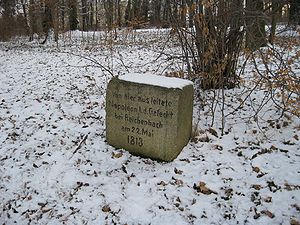Battle of Reichenbach and Markersdorf
| date | May 22, 1813 |
|---|---|
| place | Reichenbach / OL and Markersdorf in Saxony |
| output | tactical victory of Russia |
| Parties to the conflict | |
|---|---|
| Commander | |
| Troop strength | |
| approx. 14,000 men | about 16,000 men |
| losses | |
|
approx. 1,400 dead and wounded |
approx. 1,100 dead and wounded |
Spring campaign 1813
Lüneburg - Möckern - Halle - Großgörschen - Gersdorf - Bautzen - Reichenbach - Nettelnburg - Haynau - Luckau
Autumn campaign 1813
Großbeeren - Katzbach - Dresden - Hagelberg - Kulm - Dennewitz - Göhrde - Altenburg - Wittenberg - Wartenburg - Liebertwolkwitz - Leipzig - Torgau - Hanau - Hochheim - Danzig
Winter campaign 1814
Épinal - Colombey - Brienne - La Rothière - Champaubert - Montmirail - Château-Thierry - Vauchamps - Mormant - Montereau - Bar-sur-Aube - Soissons - Craonne - Laon - Reims - Arcis-sur-Aube - Fère-Champenoise - Saint -Dizier - Claye - Villeparisis - Paris
Summer campaign of 1815
Quatre-Bras - Ligny - Waterloo - Wavre - Paris
The battle of Reichenbach and Markersdorf on May 22, 1813 was a successful retreat by Russian troops against Emperor Napoleon I of France in the spring campaign of 1813.
prehistory
In the battle of Bautzen on May 20th and 21st, 1813, Napoleon was denied the destructive victory he wanted. Marshal Ney and Generals Lauriston and Reynier , who ignored Napoleon's instructions, did not effectively threaten the rear connections of the allied Russian and Prussian troops under Wittgenstein . In addition, the lack of high-quality cavalry on the part of the French made itself felt, which made a quick pursuit of the defeated allies impossible. In this way the time was gained to find safety eastwards behind the natural obstacle of the Neisse. Lieutenant General Prinz Eugen von Württemberg , who was in Russian service, was commissioned to cover this withdrawal action. He was supposed to hold up Napoleon's advancing units long enough.
Course of the battle
The first line of defense was formed on the wooded heights between Reichenbach in the west and Markersdorf in the east, about 12 km west of Görlitz . Eugen's headquarters were initially on the Töpferberg south of Reichenbach. After the troops standing here had to give way to the attacks of the French and Saxons, Eugen withdrew behind Markersdorf. Reinforcements brought in by General Prince Trubetskoi initially stabilized the situation, but the French renewed their attacks. At that moment General Duroc , Oberhofmarschall and close friend of Napoleon, was badly wounded by a cannonball. The emperor was personally badly hit by this loss and then broke off the fight - a very unusual behavior for him. Duroc succumbed to his wounds as did Napoleon's generals Kirgener and Bruyère .
The opposing troops
French and their allies
- Light Guard Cavalry Division under General Lefebvre-Desnouettes (16 squadrons)
- VII Corps under General Reynier (a total of 7 Saxon, 6 French and 2 Würzburg battalions as well as 5 batteries) with the following divisions:
- I. Cavalry Corps under General La Tour-Maubourg :
- 1st light cavalry division Bruyère (5 Saxon, 1 French squadron, 4 French, Saxon and Italian batteries)
Russians
- cavalry
- Knorring Brigade (8 squadrons)
- Brigade Pantschulid (7 squadrons)
- 3rd Division under General Graf Schachaffskoi (6 battalions, 2 battalions)
- 5th Division (reserve) under General Lukov (5 line battalions)
- 2nd cuirassier division under General Duka (18 squadrons of cuirassiers, 1 mounted battery)
- Reinforcements under General Prince Trubetskoi (20 squadrons, 6 1/2 batteries, unidentified infantry under General Mellentin)
consequences
The fighting had given the Allied troops enough time to retreat across the Neisse, to destroy the bridges and to rearrange their troops. It was not until noon the following day that Saxon pioneers were able to erect a pontoon bridge near Görlitz, it was now too late for a quick pursuit. A protracted continuation of the fighting in Silesia was out of the question for Napoleon, as many of his young recruits were unable to cope with the exertions of the past weeks, were malnourished and sick. In this situation the emperor decided to offer the Allies a truce in order to persuade Austria to join the war on his side. The opposite happened, the autumn campaign of 1813 had to be carried out with a much less favorable balance of power and brought Napoléon the catastrophe of Leipzig .
Memorial stones
In Reichenbach today two memorial stones commemorate the battle. One was set up on the Töpferberg by the Beautification Association in 1913, the other marks the location of Napoléon's headquarters in Niederhofpark.
In Markersdorf there are memorial stones for the French generals Géraud Christophe Michel Duroc and François Joseph Kirgener . The emperor personally ordered the construction of the stone for Duroc. France paid the landowner a lease fee for this until 1923.
swell
literature
- Digby Smith: The Greenhill Napoleonic Wars data book . 1st edition. Greenhill books, London 1998, ISBN 1-85367-276-9 .
- David Chandler: The campaigns of Napoleon . 14th edition. Weidenfeld & Nicolson, London 1998, ISBN 0-297-74830-0 .
- Siegfried Fiedler: Warfare and Warfare in the Age of Revolutionary Wars . Bernard & Graefe, Koblenz 1988, ISBN 3-7637-5808-9 .
- Frank Bauer: Haynau May 26, 1813 . Edition König und Vaterland, Potsdam 2010 (Small series History of the Wars of Liberation 1813–1815, no. 35).

